Book contents
- Frontmatter
- Contents
- Notation
- Foreword
- Preface
- Introduction
- 1 Rearrangements
- 2 Main Inequalities on Rn3
- 3 Dirichlet Integral Inequalities
- 4 Geometric Isoperimetric and Sharp Sobolev Inequalities
- 5 Isoperimetric Inequalities for Physical Quantities
- 6 Steiner Symmetrization
- 7 Symmetrization on Spheres, and Hyperbolic and Gauss Spaces
- 8 Convolution and Beyond
- 9 The ⋆-Function
- 10 Comparison Principles for Semilinear Poisson PDEs
- 11 The ⋆-Function in Complex Analysis
- References
- Index
11 - The ⋆-Function in Complex Analysis
Published online by Cambridge University Press: 22 February 2019
- Frontmatter
- Contents
- Notation
- Foreword
- Preface
- Introduction
- 1 Rearrangements
- 2 Main Inequalities on Rn3
- 3 Dirichlet Integral Inequalities
- 4 Geometric Isoperimetric and Sharp Sobolev Inequalities
- 5 Isoperimetric Inequalities for Physical Quantities
- 6 Steiner Symmetrization
- 7 Symmetrization on Spheres, and Hyperbolic and Gauss Spaces
- 8 Convolution and Beyond
- 9 The ⋆-Function
- 10 Comparison Principles for Semilinear Poisson PDEs
- 11 The ⋆-Function in Complex Analysis
- References
- Index
Summary
The star function was originally developed to prove the spread theorem, a problem dealing with meromorphic functions in the complex plane. The first sections prove the spread theorem, along with other applications to the study of these functions. Later sections center on analytic functions in the unit disk. The star function technique yields to sharp estimates for integral means of univalent functions and the (harmonic) conjugate function, along with the behavior of the Green function and harmonic measure under symmetrization. The final section extends some results to domains of arbitrary connectivity. The chapter includes the necessary background in Nevanlinna theory and the Poincaré metric on hyperbolic plane domains, and in almost all cases, the mappings which exhibitextremal behavior are identified.
Keywords
Information
- Type
- Chapter
- Information
- Symmetrization in Analysis , pp. 398 - 453Publisher: Cambridge University PressPrint publication year: 2019
